In the weeks leading up to Rob Pruitt's recent two-gallery solo show, "Pattern and Degradation," there have been a handful of big profiles on the artist, with words like irreverent and splashy describing his rise, then his fall, and finally predicting the trajectory of his career. But I feel even since the opening of the show, showing simultaneously at Gavin Brown Enterprise (GBE) and the neighboring Maccarone Gallery, less focus has been given to, well, the work, as has to opinions about its creator. Critics are quick to develop or enhance the 'story' with the main character Rob Pruitt, but who really is Rob Pruitt and what story is he telling? I thought I'd offer this platform for Pruitt to talk about the show himself via an interview. A couple weeks ago we scheduled the interview and a few days later, I got a call from GBE asking if, in lieu of a 'traditional' interview, I would like to participate in a communal lunch with Rirkrit Tiravanija and his Columbia University Sculpture 3 course and walk-through of the show led by Pruitt. The idea sounded wonderful -- not only would I get to enjoy a Tiravanija-conceived lunch but then get additional questions from a class of sharp art students for Pruitt on the show.
It was a stellar decision. The Gavin Brown Enterprise is a refreshingly laid back place to spend the day -- granted there was construction going on around us in the back kitchen/dining room area (soon-to-be a kitchen-meets-stage-meets who knows what else; if anyone can do it, Brown can) ... but the hammering and drilling around us made the experience all the more livelier. Rirkrit has a wise and kind spirit and zen nature that comes through in his community-based installations and happenings. I've followed his work since I participated mildly in the reconstruction of his (then) East Village apartment in GBE, which was open to the public 24 hours a day, as well as free meals at David Zwirner and 303 Gallery. His happenings are never pretentious but purely enjoyable, transgressive, and to the core of what makes him an artist -- affecting his audience on many levels.
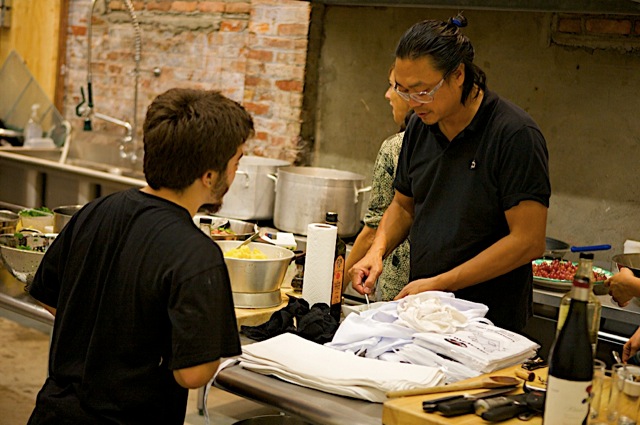
Tiravanija with student, © Ruthie Abel 2010
So after a delectable rustic lunch of arugula with squash, plump slices of mozzarella and toasted pumpkin seeds, followed by three different spaghetti dishes (my favorite was with clams and garlic), and finished with fresh figs and ice cream, when all dishes were finally cleaned, the now well-fed Rob Pruitt and myself, with Rirkrit's class of both graduate and undergraduate students and photographer Ruthie Abel, who I met that afternoon, made our way through the show.
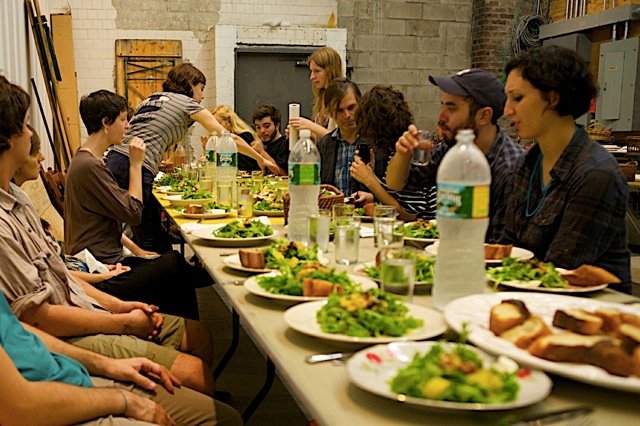
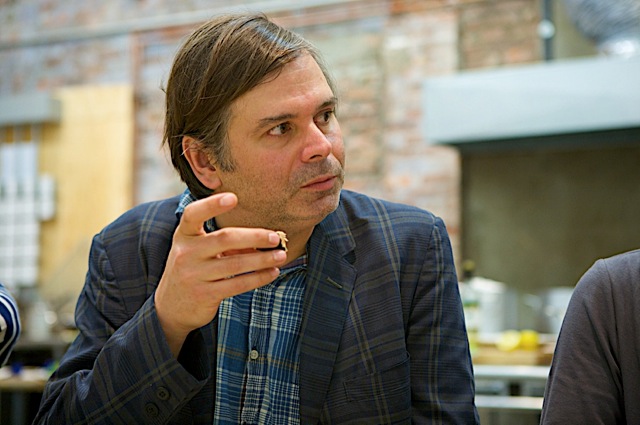
Both © Ruthie Abel 2010
What really impressed me about Pruitt is his candor and willingness for feedback. He seeks approval to some degree, but only as any human -- and one who was perhaps unfairly targeted for so long -- might (that's not to say, however, that I didn't find his Pruitt-Early show at Leo Castelli Gallery somewhat offensive myself, but at the same time I felt that it offered a perspective on a particular time in pop culture, albeit a narrow perspective). So, as we took a walk through "Pattern and Degradation" (below is Vernissage's wonderful video footage of the show), here is what Pruitt had to say:
Rob Pruitt: Everybody knows what Rumspringa is? It's this period afforded to the Amish teenagers to leave their Amishness for an entire year and try all the sins of the outside world. Whatever -- rock and roll music, parties, drugs. I became interested in it because back when I was 24 and I collaborated with this person Jack Early and we were known as Pruitt-Early, our first and biggest project was art with teenage boys. We did a cultural investigation where we thought that American society propelled adolescent males into this power position based on all of this cultural trash we collected, like t-shirts that were misogynistic and gave them all the power. It reinforced this male rebellion and rage and we couldn't really find a counterpart. Years later the riot girl kind movement was around but not in 1988 when we were making this artwork for teenage boys.
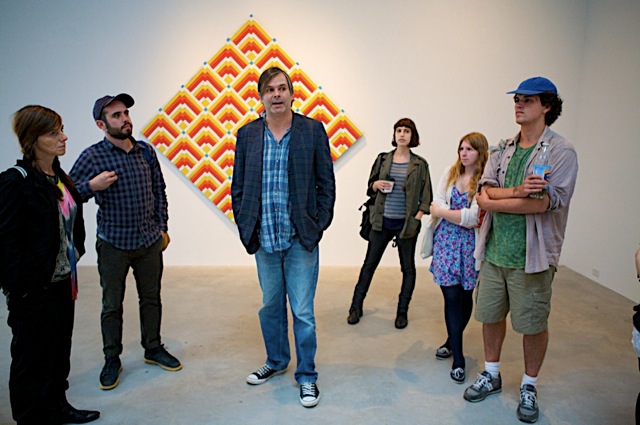
© Ruthie Abel 2010
Twenty-two years have passed since I had thought about a teenage perspective when I was making the things I was making. And there were all of these pop culture stories about Rumspringa: MTV made a documentary, there were books and magazine articles. I became very interested in a culture that is so closed off like the art world is closed off from the rest of the world, even though art is a commentary of the moment. But it forces its youth out of the community to experience something other, the outside world.
I realized it was very much like the way I had chosen to spend my life as an artist. Being part of the world yet living just outside of it, outside the mainstream, experimenting artistically. In terms of lifestyle I mean this whole block of time 15 years ago, I'm not proud of it.
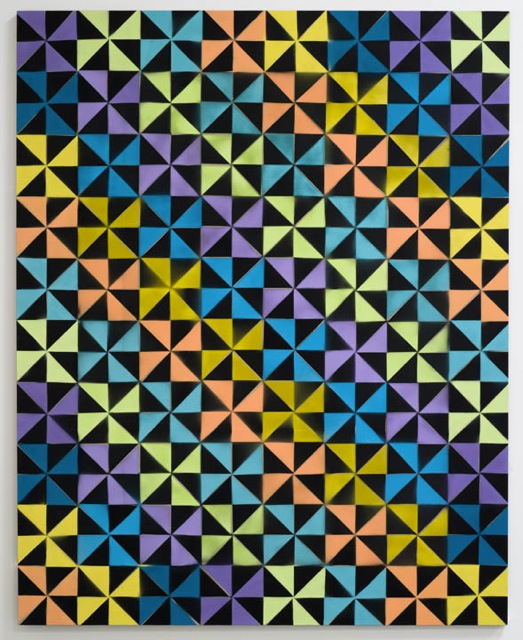
Rumspringa Quilt: Broken Dishes (Pastel), 2010. Spray paint on linen, 90 x 72 inches. Images courtesy the artist and Gavin Brown's enterprise, New York. Photography: Thomas Mueller.
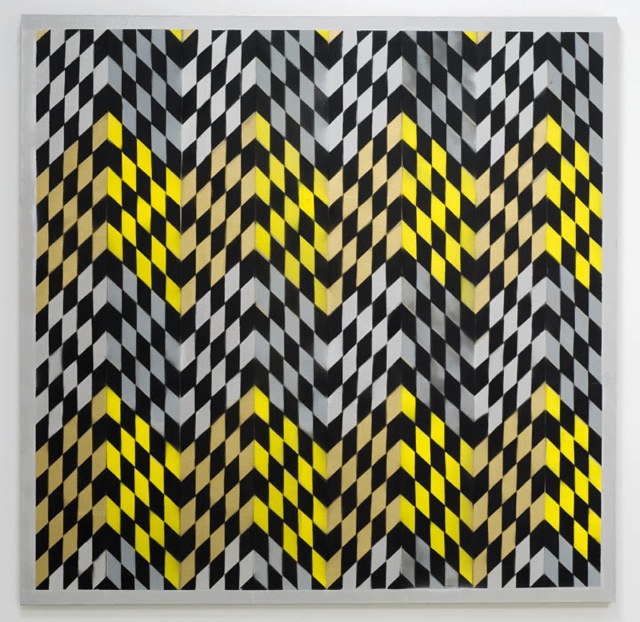
Rob Pruitt, Rumspringa Quilt: Nascar, 2010. Spray paint on linen, 80 1/4 x 80 inches. Images courtesy the artist and Gavin Brown's enterprise, New York. Photography: Thomas Mueller.
When you look at these paintings, what do you see? Do you see them as quilts? Quilt iconography?
Columbia Student (CS): I notice that they all have frames.
Well the Amish make borders for their quilts. There are four more that aren't hanging in this room. The pink and silver one has a clear-cut border. And the borders are in the proportion.... I still wanted it to be a painting and not just a duplicate of an Amish quilt so I left the spacing that the Amish would have stitched a boarder on. But I thought the Belgian Linen - a traditional artist's material - looked really nice with the brightly colored graffiti spray paint. It's a special brand called Montana Gold, with a palette of over 150 colors.
CS: Like this square one...
Especially this one where it's a very typical pattern. It's called snowflake.
CS: I noticed that when you look at them you experience some sort of optical illusion. It tricks your eyes - it looks like it's spinning or the pattern seems like it is moving. Also, it's a departure from quilt patterns from its color usage.
Plus I can make one of these in an afternoon. A quilt can take years with several people working on it. This is a real attention deficit approach. But this speed and the fumes from the paint are really... it's like taking drugs while making art. The fumes are so strong. From my personal experience of making it ... That was also part of it.
CS: Did you use stencils?
Yeah, the shapes are cut out of cardboard first. It's an extensive process.
... And so many artists have been inspired by these quilts, like, Barnett Newman and Kenneth Noland. I mean there's this huge list, so, again for that reason I thought it would be fun territory to explore because that was years ago and they weren't thinking of rumspringa. They were thinking of pure geometry and optics.
CS: Did you choose spray paint to have a relationship with a kind of rebellious attitude?
Well, yes, and the speed. Also graffiti artists and huffing, which getting high by breathing in the fumes. And I was interested in keeping it like a textile art; this still seems like fabric to me.
Marina Cashdan (MC): Did you spend any time in an Amish community?
No, my family is in DC so the past two family trips I made for Christmas and a family reunion I drove through the Pennsylvania towns - mostly Lancaster - and spent a week there. But I didn't try to infiltrate or meet anyone. I went to the standard tourist attractions: quilt museums, farmer's markets...
[He walks us to a work on an opposite wall, another quilt work]
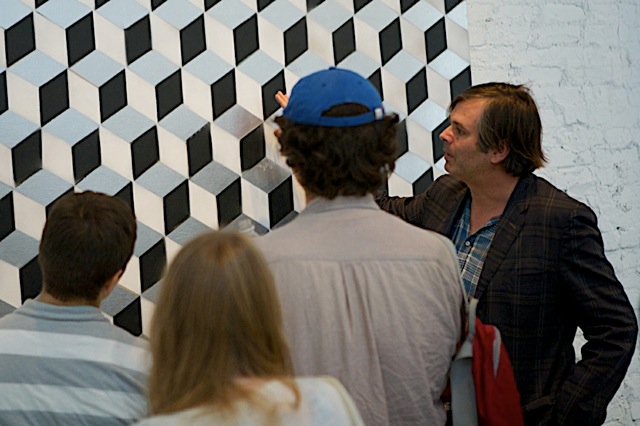
© Ruthie Abel 2010
The Amish call it tumbling blocks, but the real reason I made a version of it was that when I was 18 and moved to New York to go to Parsons, Parsons had a relationship with NYU -- we could take our academics there -- and when I was getting a tour of the library the tour guide pointed to the floor, which is in this tumbling blocks pattern, and talked about how the architect chose this design as a suicide prevention. It would be intimidating to jump onto a floor that had a sharp optical effect. Also, the guard rails, if you look at them from an overhead perspective, of look like crucifixes, like crosses. But, one quarter of the cross is a little shorter. Some stories just stick with you. It's been 25 years and I really like the suicide prevention story.
And it's not really the Amish that say god is in the details but I love that expression and I love the way when the Navajo people weave blankets with intentional imperfections in them -- they believe the only perfection is nature. I love that the details are really crappy [on this work]. A lot of the times the cardboard would stick, and overspray underspray little seepages. To me that's... nice.
[We then walk to Pruitt's self-portraits.]
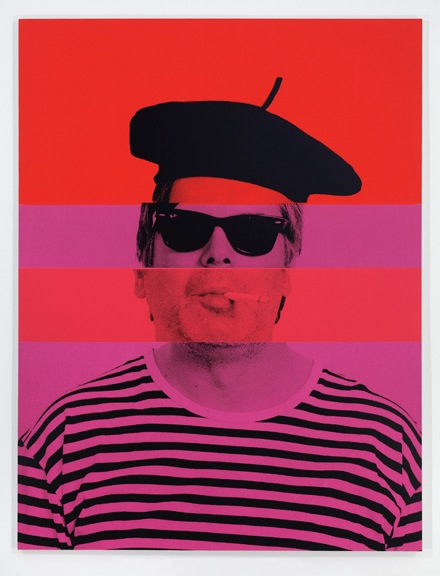

© Ruthie Abel 2010
I haven't really done anything that had resembled self-portraiture since early collaborations with Jack Early. And that was 22 years ago. I had been thinking about other artist's forays into self-portraiture including some of my friends, like Elizabeth Peyton who shows here -- her great self-portraits. Another artist that shows here Jonathan Horowitz made this show that was at Greene Naftali [Gallery] 11 years ago called "The Jonathan Horowitz Show" where he made rows of monitors and had one monitor for every 2.5 years of his life showing all of the media he had consumed during those periods of his evolving maturity. And I thought that was a brilliant example of self-portraiture.
It made me challenged and envious. I wanted to try it again. The first attempt was a collaboration [with Early] so it involved sacrifice.
Even though collaborations make great things there is always a sacrifice. You're not really making the work, or at least I found this to be the case. I didn't make the work 100 percent. So I wanted to address self-portraiture and tell some sincere stories about myself with one picture.
And this is what I came up with in the past year -- this system that is based on the exquisite corpse drawing when the paper would be folded and you wouldn't know what was coming before you or after. You wouldn't know what was revealed until the end. Of course, since I did all four sections that kind of got thrown out the window. But I took 300 pictures [of myself] with different props and tried to piece them together of who I think I am and who I want people to think I am.
MC: And the truth behind each one?
You know the lot of it is personal or stupid, but it's almost better when you, the viewer, stands in front of it and tries to figure out who this man is with the princess tiara and the monarch butterfly on the nose. And... it's a red rose but it's a reverse negative so to me it has a vampire feeling, not just a romantic with a red rose but some sort of devilish romantic.
And then the princess part, it's not that that I felt privileged, but I don't really walk around feeling like I'm a man. I dress like a man, but I feel kind of between genders. It's hard for me to explain; I think I just wear these clothes because it's easy. I don't' have to think. But I just feel like something in between. So it was important in several of these. I have some false eyelashes, there's one in the other room where I have a big plastic dildo in my mouth, and that was like a bold gesture for me. I wanted to deal with my gayness in a way that is right there, in that sense it turns it into a joke, but when I did it ... I still don't think that it's a joke. I've had penises in my mouth and I've gotten great pleasure from it, or sometimes it's awful, but it's something that I do and something I don't feel like hiding.
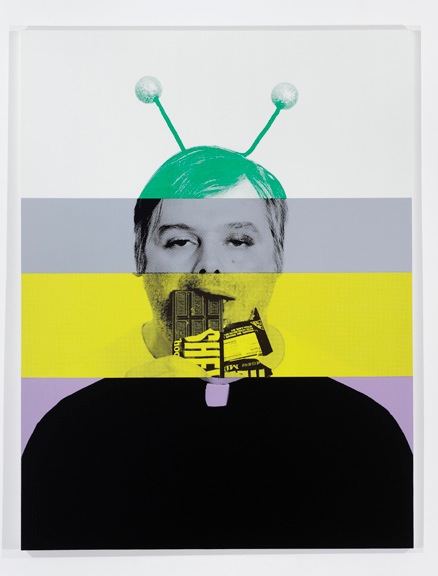
Exquisite Self-Portrait: Father Martian, 2010. Silkscreen on canvas, 84 1/4 x 63 1/2 inches. Images courtesy the artist and Gavin Brown's enterprise, New York. Photography: Thomas Mueller.
This one [he points to a self portrait, he has gray hair, futuristic glasses and a pipe dangling from his lips] is not about me, but it's imagining depictions of the past and the future. You know like A Clockwork Orange was a view of what the future will look like but made in 1971; it's interesting to look at it 40 years later... it looks a little antique, it's not like Mad Max. So [in the painting] I've given myself gray hair and futuristic sunglasses. It may not look like the future 20 years from now, it may look like antique glasses. We're not really sure. But then I've sepia toned the mouth section with the pipe, this is not a pipe, this is a real symbol of the past for me.
So that's how these go together. I really enjoyed trying to make a story in each one. Sometimes they're really professional, sometimes it's an art joke. One thing I noticed in the end, I tend to be orally fixated...
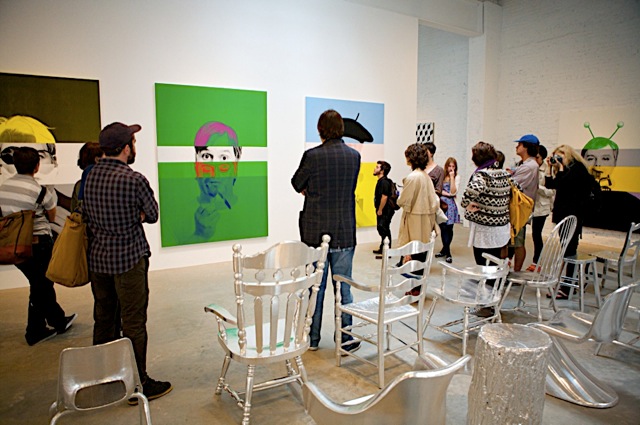
© Ruthie Abel 2010
MC: The chairs lined up this way seem like some sort of arrangement for worship. Are they looking to your portraits as a religious figure?
When I planned it, it was really supposed to go with the quilt paintings, but that's the luxury of making a lot of work and then showing up at the installation -- you can shake things up. I was thinking about how the Amish don't go to churches and they just have their meetings in their homes and my fantasy is that they're always different chairs, they're not matching chairs like in a church or a temple, and that difference between the chairs made me think of individuals but yet now they're part of a collective because they're all assembled, they believe in the same thing. Beyond religion I was thinking about others who believe in the same thing, maybe the art community or the people who show up to see my show.
I've been somebody that people have known for 15 years and some people will definitely stay away from this show. They have no interest in anything I do. Others will rush to the show, they can't wait to see what I have recently done.
It also related to Woody Allen. A theater all assembled and pointed in the same direction to watch a film. It's about a preacher, a gospel, or looking at all of these portraits of me. And I am that person that this group is following, at least in this installation.
CS: And why are they silver?
Because... it just looks so cool to me.
CS: Can I ask about the production? Is it basically chairs covered in ... what is the material? And where did you get the chairs?
It's called plumbers tape. And I spend a lot of time in Montauk, you know, on weekends. I would look in New York Newsday for house sales and estate sales. I tried not to spend more than $10 on any chair, maybe 20 percent of the chairs I found on the street, another 20 percent from Salvation Army on 46th street (they have a parking lot), and then house sales.
[Pruitt moves on to the work Panda Pattern: Woody Allen]
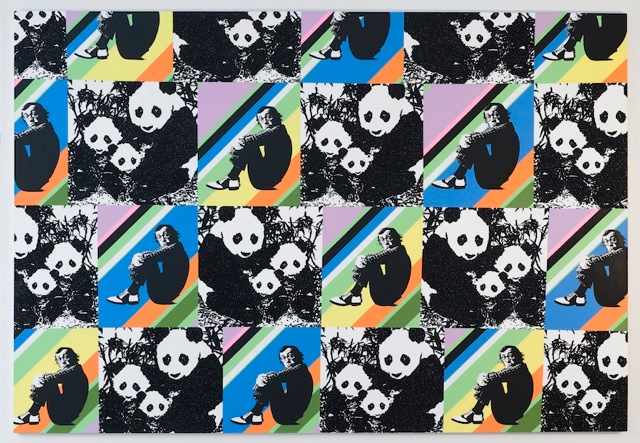
Panda Pattern: Woody Allen, 2010. Acrylic, enamel and glitter on canvas, 96 x 138 inches. Images courtesy the artist and Gavin Brown's enterprise, New York. Photography: Thomas Mueller.
I started making these [panda] paintings like 13 years ago. Always single subject. And the repetition of this family of pandas is a remake of an earlier painting from like 10 years ago. And I was thinking of bringing back patterns for a couple of different reasons: I was taking cues from the pattern of decoration movement of the late 60s, and early 70s where subject matter was not important, just a record of experience or pure pleasure of looking at things. It didn't have to be anchored with political or social subject matters. But I had an impulse to time stamp it, create culture. I'm doing all these things at once in this painting, I think... but it could be traced but something kind of irrelevant and personal, to myself.
I grew up in the suburbs of DC. My parents didn't really care about the arts, but somehow we ended up with a subscription to Architectural Digest magazine. I can remember being about 8 or 9 and looking at this magazine, this issue, it had Woody Allen's apartment in it. I noticed he was collecting antique quilts and shaker furniture, simple chairs. My 13 year old mind was thinking, here's this man who is the picture of urbanity, of city sophistication, but he is interested in surrounding himself with these symbols of a lifestyle that is anything but what the subject matter of his films are.
I was really thinking about this moment in my career when I had a show ["Red, Black, Green, Red, White and Blue"] at the Leo Castelli Gallery, in 1992. It totally exploded in our faces. We tried to make a show about black pop culture so we collected as many -- and this is pre-Internet -- as many icons of black celebrities as we could. The way we did that was in collecting posters. Posters used to be a much bigger thing, teenagers still buy posters for their bedrooms, but it used to be a huge industry, like art posters for your living room... so we collected about 400 posters and they really cross referenced, uh... the... black American celebrity, ranging from political to sports to singing and acting personalities, and we made these montages and collages. The show opened on a Saturday and there was a review in Monday's paper calling it an abomination -- how could this esteemed gallery show this racist artwork? I was just 26 at the time and I was really stunned by it.
It was not my intention. My intention was just the opposite. Having grown up gay in the suburbs, I knew what it was like to be ostracized and picked on and separate from people who were having the easy life, at least in the microcosm in a 400 count student body. I felt isolated and separated and picked on. I thought that gave me some sort of intellectual passport to deal with this sort of material.
But at that time, it was about identity issues and politically correct work. If you were of a particular group of people, then you were making work that was of that group that you belonged to. You were not speaking about people outside of your group. You guys probably know just as much about this as I do, except that I lived through it, you've read it in books. So I was thinking about single explosive moments that end careers.
That wasn't a choice it was a misstep...
Well, whatever, I was thinking about how Woody Allen slept with his 16 year old stepdaughter, you know, possibly who knows what happened but it threw 35 years of hard work just out the window. He turned into a media freak, just somebody who was judged by these morals and ethics... and there are more people other than Woody Allen who do that. I was thinking, why do they do that? Do they think that they've amassed so much power that they're not held to the same... rules? They just have become so disassociated from society that... that they are literally in another place? Or is it self-sabotage, where the pleasure of their success isn't really that meaningful and it's more meaningful to tamper with it, test it.
But someone will stand in front of this painting of me being nude and just start laughing and come up with his or her own reason why it's hanging there. But that's what I was thinking about.
CS: Did the collaboration between you and Jack Early continue after that?
The collaboration was also a romance, and when the reviews came out it just ended. I think it was my fault; I just wanted to start over with all aspects of my life. I started making work by myself, my first works in college I made alone. And I would have dealers over for visits and they were like, 'You know your name is just too dangerous to show you', 'You're sort of a laughingstock,' or 'Even though I find interest in what you're showing me, it's just not the right time. You have to let time pass.'
There was a pile of excuses and I just kept on making more work. There was a pile of work in the corner of the studio because none of it was being shown. I just came upon the symbol of the panda as a bit of a... public apology. It's equal parts black and white; it's on the brink of extinction. So maybe it evokes guilt, we are complicit in the reason it is more of an icon rather than an actual living creature and that representations far out numbers actual pandas. And it's vegetarian and I've been vegetarian since I was 13, which I did to make my parents angry
CS: Did you feel guilt?
I did, because in the end whether I intended to or not, I made a lot of people very uncomfortable. Friends of mine who are a black Americans were insulted by it, or they got caught up in the frenzy. Anything 20 years later is a bit of an exaggeration, but they wanted a personal explanation from me. They were like, 'Okay, so many the papers got it wrong, but you tell me, what were you trying to do?' And then people I didn't know were upset by it. You don't always have to apologize for things you are guilty of.
CS: How did you respond to your friends?
Just as I started to give you an explanation, I did that, but then it became a dialogue.
Some of my friends would say you can't represent a very diverse group of people like musicians and actors and doctors and legislators and singers together because they share the same skin color. That's not progressive thought. If it was a painting about politicians and you had politicians of many races, you can organize it that way. This is just an example of that kind of discussion. Though I thought a lot of it was a little overwrought and it's hard in the moment to see what's going on. Moments define themselves very slowly.
MC: Do you feel that when groups create a target, everyone else starts to form around it?
Yeah, there is a term for that, group mentality or something... but I also didn't know that I was 100 percent innocent. That was what was most exciting. Even though it was stressful. It wasn't just a Brice Marden painting.
MC: Do you think that often art serves as a mirror?
Yeah, and I think there's also... not to turn your question around but there's this crisis like this position that the panda takes, it's dying for our gluttony, and I felt a little bit like that.
Not that I'm like a panda, but I felt like being taken down as a symbol of somebody who didn't play by the rules, when the rules were extremely important. It was a highly social and politically important moment in art making, like a moment to be responsible, not to be reckless.
[We move to the next gallery.]
In 1999 I had a show and during the period when I wasn't working one of the things I did was work at Martha Stewart Living magazine. I worked on the "Good Things" column. I always feel uncomfortable telling people this story because I don't want people to think that I was a big shot there. But I did have this job and I had some advancement through the system. It's a really interesting place to work, if you think about doing anything other than just pure artwork. It's really like college part 2. I found it exhilarating.
MC: There are some brilliant people who work there.
Yeah, I actually got a lot out of that job. I would have to come to a Monday think tank meeting with 10 or 20 ideas for a particular issue. Like the February issues based around Valentine's Day and the coming of spring. So I was working on the "Good Things" column which is like doing little craft things. Just think of as many ideas as I possibly could relate to those topics, like flower bouquets, but instead of the cheap paper the florist gives you, wrap it in a map of the city that is meaningful to you, like roses in a map of Paris. Take a heart shaped cookie cutter and use it to slice beets and float them in potato soup as a first course. I can remember Martha saying, "Oh, that's an awful idea, it'll look like a murder or something." So she changed it to putting them on top of a tossed salad. Whatever. It's a creative debate, and it's better than waiting tables.
So anyway, in 101 Art Ideas [a conceptual art installation by Pruitt], there's a chapter on self-portraiture. It was 12 years ago, or I don't remember exactly, but one of the ideas is to transcribe all of your voice mails. I did that 12 years ago for that show and presented it as self-portraiture.
But when I was thinking about the show and how it fit into pattern and decoration ... I check my email like ten times a day. I was fascinated by the pattern of people coming into my life and leaving my professional life, certain emails I didn't open. It would be just as good if you turned it on its side, like an EKG machine.
It's also just interesting the information that came out, like how the Egyptians would prepare one of their kings or queens for the afterlife by putting as much stuff into the pyramid as possible, like pretzels and tires and panda bears and quilts, and this to me was sort of a wall of hieroglyphics. They of course knew what they were reading but we look at hieroglyphics like an art. There's a beautiful pattern and decoration.
MC: Would you consider hanging it that way in another installation of the work?
Yeah, I think so. It would look really nice.
MC: Where did you get these tires and how did you decide what sweets or foods to put in them?
I started collecting tires just from the dump by my place in Montauk. There's an entire section for tires. I started with the smallish ones and then when I started to think about what I was actually going to do I realized I needed bigger ones. A block over from my studio in Brooklyn there's a place where truck tires get changed and so I went there.
MC: You can see where some of them have been damaged.
Oh yeah. All these won't work as truck tires anymore. But I love the idea of, I mean, there's a hole in this logic, but, I love the idea of taking something that was meant to go to a landfill - I presume these were going to be recycled, but I don't even know if it's possible to recycle tires, I know that's a problem, sometimes they sink them for coral reefs. They always grapple with this enormity... there are all these cars and all cars have four tires and tires have to be changed once a year... somewhere there's like a mountain of tires. And so I just think it's a nice way to think about a way of instead of hiding trash, raising the curtain and dealing with the ugly stuff as the pretty stuff.
For instance in this stack, look at these patterns put in with the white paint, it's just very pretty to me. Maybe it's a little bit like your teacher Rirkrit, even though it's not. His work is about an experience... that nurtures more than just the visual, the soul the body, most of this is just 100 percent sugar. So it's not really Rirkrit even though it relates to Rirkrit and it relates to Felix Gonzalez-Torres and that's even... more sacred than Rirkrit's pieces in a way, because those are more about his boyfriend Ross and AIDS and the candy starts at Ross's body weight when he was still relatively healthy and then metaphorically ... well, people start taking the candy. It's a parallel since you're watching him waste away. These are really poetic things that Felix and Rirkrit have done.
Mine I think is a little more sarcastic. It's more about the gluttony of our culture: There's a young person who works here and her top desk drawer is just full of candy. And when she isn't eating candy there's a cigarette break. And between cigarette breaks and the candy and there's a trip to the corner to get a diet soda. I'm not singling this person out, I'm singling out the behavior of collective condition. We just can't do a simple task without having to stimulate ourselves, so with the show being next door, it's kind of a joke about how you might not be able to get through all of it without having a sugar break.
CS: Is the fluorescent light [around the tire] a wakeup moment for the audience? How did that come into it?
Well, it's more about the absurdity of enormous candy dishes. And communion, you know, taking in the Catholic Church, the wafer and being a very small child. Also the candy dish in my grandmother's living room, and the living room wasn't even a place to live in; it was sort of roped off, so sneaking in to visit the candy dish ...
CS: It's like the way we feed hummingbirds refined sugar to watch them come to the window for more.
It's like a drug machine. Feeding a hummingbird this cane sugar mixture is creating a little hummingbird junky. It is selfish. Plus I think that if you have ingested sugar there's going to be a different physiological experience looking at art. You get a rush from sugar, and then maybe you can't tell the difference between a visual rush and a sugar rush.
Is that where the florescence comes in?
Yeah...
There's something that I want to discuss. This image [of a panda screaming, on the opposite wall] I snapped on the street about a month and a half of ago. This guy was wearing a t-shirt and the panda was just screaming and it was really great. It's mostly pictures of pandas I've looked at for the last 12 years, but I've never really seen one like this. And so there are a couple of blogs, people saying a lot of things about plagiarism, that I should be sued for stealing this image, but nobody is asking how I encountered the image...
[We walk next door to Maccarone Gallery.]
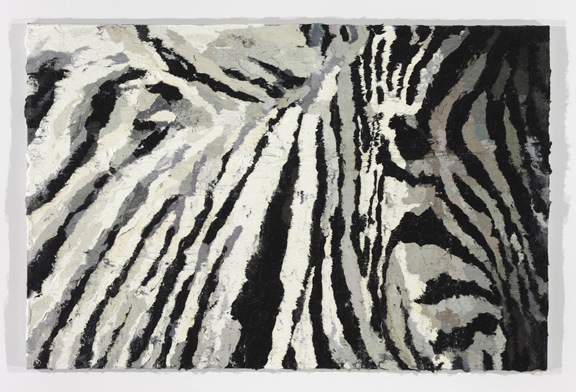
Pjätteryd Oil Painting: Zebra, 2010. Ikea stretched inkjet printed canvas wall art, oil, 30 1/2 x 46 inches. Images courtesy the artist and Gavin Brown's enterprise, New York. Photography: Thomas Mueller.
IKEA has a new line of wall art every year for 49.99, and this is just this year's grouping -- two Klimts there and that one is like urban graffiti on a city wall.
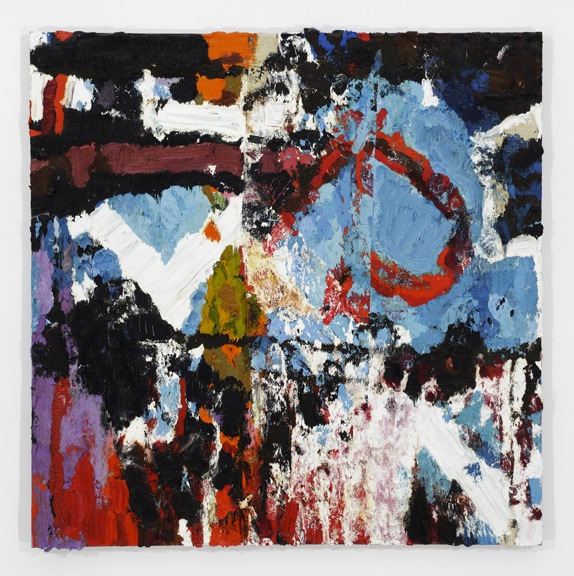
Pjätteryd Oil Painting: Graffiti, 2010. Ikea stretched inkjet printed canvas wall art, oil, 35 1/2 x 35 1/2 inches. Images courtesy the artist and Gavin Brown's enterprise, New York. Photography: Thomas Mueller.
CS: You put oil paint on top of that?
I painted right on top of the IKEA painting.
MC: Paint by numbers.
Yes, but it's messy.
CS: It's really nice.
And these are Cinnabons where I put paint in an icing bag and squeezed it out and sort of made five patterns. There are actually 100 [Cinnabon paintings], on this wall there are 75, there wasn't a wall large enough... I wanted the recycled cardboard monsters to not look at the real art but have this obsession with sugar and white flour. This was the perfect wall. It really is born out of this love for Sol Lewitt's wall paintings.
This whole show came about because I made a big monograph last year that came out in February that had everything I had done over the past 20 years. It really was a self-reflective moment. I had to look at myself and the work I had done in my adult life, taking ownership all over again for what I had done. I knew this show was coming, so after that experience I had a short list of how I wanted to change. Like, I always found myself in this predicament as a child, when in September for the first day of school, showing up and not being that person who is made fun of for having the wrong shoes and not knowing what was cool. I thought that I had liked some of the things I had made but there were holes. I hadn't expressed my true artistic self and I wanted to do that.
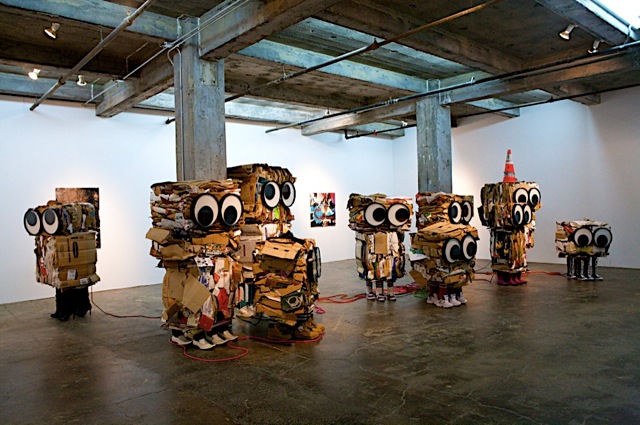
© Ruthie Abel 2010
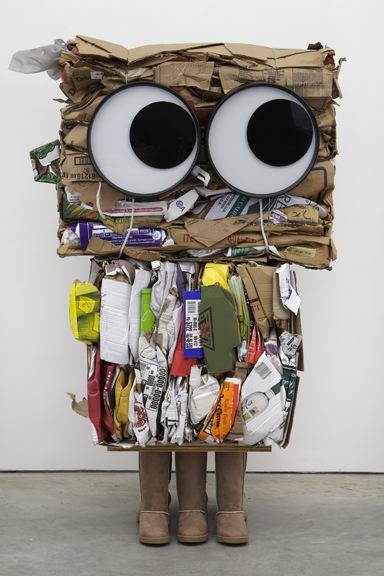
Cardboard Monster: Corinna, 2010. Baled cardboard, shoes (all man-made materials), refitted electric clocks, wood, Comme des Garcons Odeur 53, wood, extension cord, 66 x 35 x 26 inches. Images courtesy the artist and Gavin Brown's enterprise, New York. Photography: Thomas Mueller.
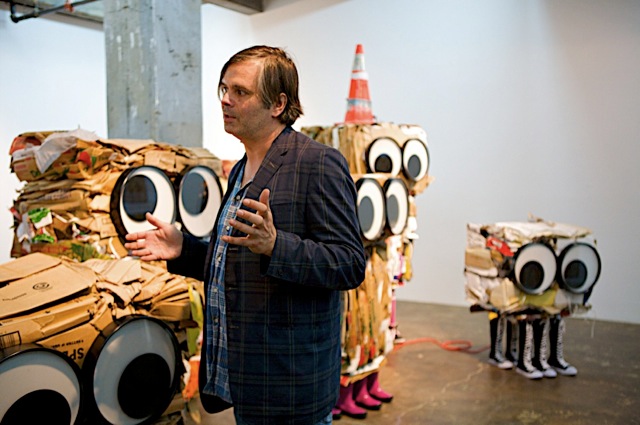
© Ruthie Abel 2010

© Ruthie Abel 2010
If you look back at everything I've ever done, there's a basic formula of taking minimalist configurations and then plastering trash pop culture right on top of this minimalist building block.
I wanted to take away the plastering. I know that each art movement is a completed thing that has happened in a period of time and you can't go back in time and try to make a minimalist sculpture even though that's not what you respond most. I knew that but I wanted to try something minimalist. That's what these cubes are supposed to be. This is my version of Donald Judd, but this is more like Jim Henson, stupider than that, actually.
[We move into the back room.]
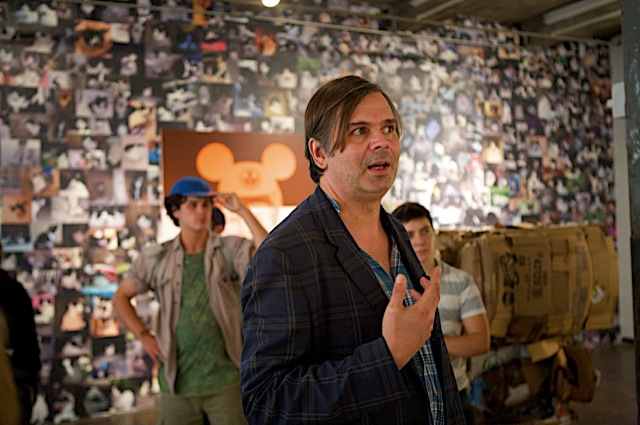
© Ruthie Abel 2010
So... this is the final room. This is a third wallpaper project. There are a couple of websites where people post pictures of their cats that look like Hitler, one is called Kitlers. It's ridiculous.
It's hard to really know which of them aren't just Photoshopped. They're all real. So I took this self-portrait away from the self portrait room... there was such an obviously pun about cat and mouse. Some things are just too irresistable to pass up.
And this panda is sitting in chairs by [New Yorker cartoonist artist] Saul Steinberg. I doubled the drawings an added my hand drawing of panda bears. Each chair has one of my panda bears sitting in it.
And then this [not shown] is a fabric pattern from this dress from Lilly Pulitzer. It's a beachwear label popular in the '60s and '70s, a preppy clothing line, not so popular now. They had a panda pattern that I copied.
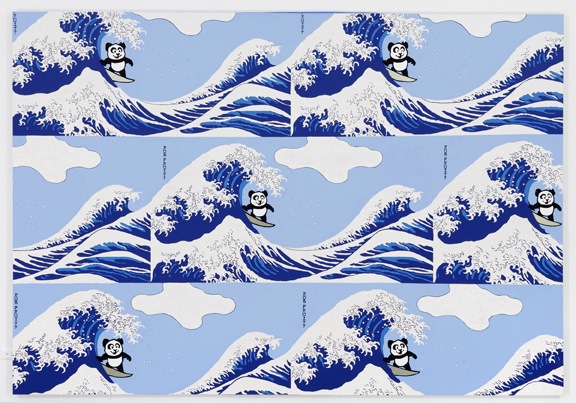
Panda Pattern: Riding The Great Wave, 2010. Acrylic, enamel and glitter on canvas, 96 x 138 inches. Images courtesy the artist and Gavin Brown's enterprise, New York. Photography: Thomas Mueller.
This is pretty self-explanatory, on of the most famous artworks in the history of civilization, and I added the surfing panda.
CS: Did you hand draw that panda?
It's kind of a composite. It's something that I found, it wasn't quite cute enough, but I changed it. I didn't start from zero. I found something and then adjusted it.
CS: How did you get the Lilly Pulitzer panda print? Did you contact the company?
I didn't contact the company. I went to the shop and took some iPhone photos and then pieced it together. The real image is a little crisper, but I tried to do the best job that I could to piece it all together. This is from a sleeveless sundress.
MC: It seems like a lot of your work is about patch-working. Is that how you approach- or define your practice?
I guess so, I never really thought of it. If I had had been able to find the entire thing on their website, that would be better than...
MC: I mean more like you take things from different sources and then put them together and edit..
That's true. If you go to these Kitler websites, there's a list of the cats' name and the person who posted the photograph and the details of the day. I isolated it and made this mosaic. I threw away all the ones that I thought were Photoshopped, and anything that seemed to have too much do with Hitler, like if there was a swastika in the background I threw it out. I think that for most of these people it had nothing to do with a political atrocity, it just has to do with 'Isn't it funny that this cat looks like Adolf Hitler?'
~ end ~
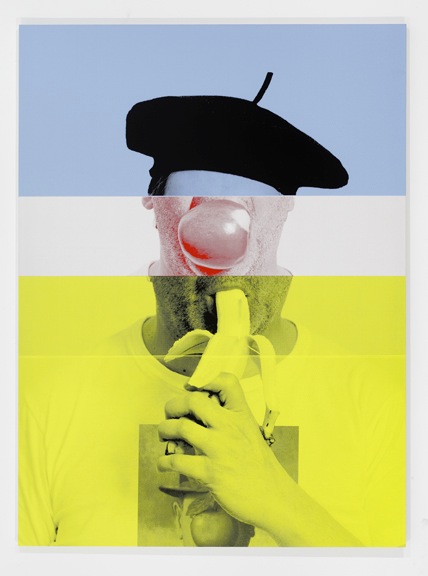
Exquisite Self-Portrait: The Surrealist, 2010. Silkscreen on canvas, 85 x 63 1/2 inches. Images courtesy the artist and Gavin Brown's enterprise, New York. Photography: Thomas Mueller.